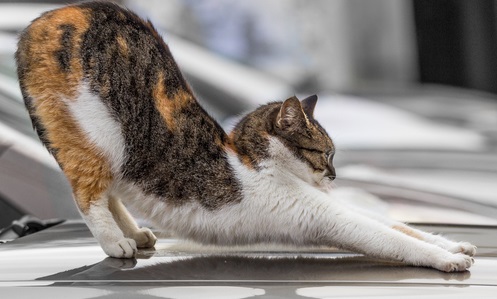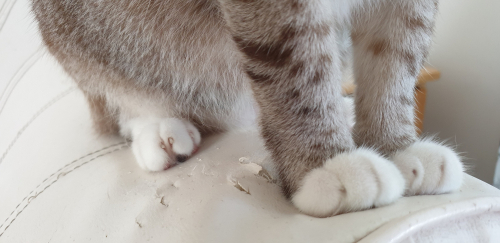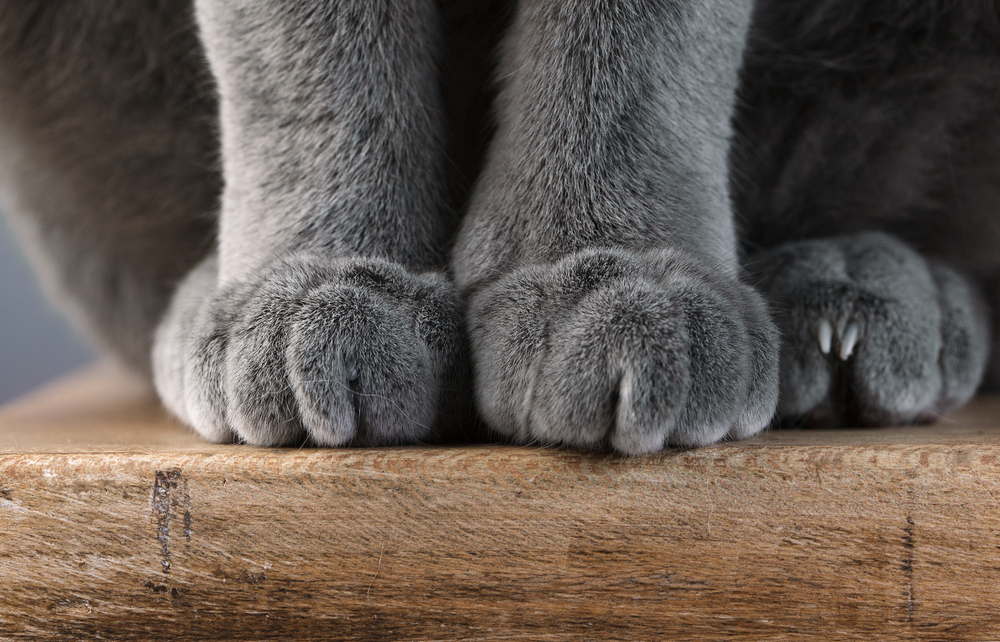For cat parents, the following scenario is all too common: the family kitty jumps up on the sofa or bed where his humans are sitting, and begins to rhythmically knead his front paws on a pillow – he may even purr his little heart out while doing so. Whether the cat is kneading his paws into the carpet, a couch cushion, a fluffy comforter, another pet, or even his parent’s lap, this behavior is very standard in domestic house cats.
Veteran fur baby folks have a few nicknames for kneading – some people call it “making biscuits”, while others may refer to it as “kneading dough”, “giving a massage”, “marching” or “paddling”. While this sort of activity is perfectly normal, some pet folks – particularly first-time cat owners – may be wondering, “what does it mean when a cat kneads his paws?” Read on to learn why cats knead their paws, including the science and psychology behind this instinctual feline behavior.
Why Does My Cat Knead Things? Common Theories About Your Kitty’s Behavior
As mentioned, kneading is a natural and instinctive behavior observed in felines. This activity typically takes place when the animal is in a state of ease: the cat will alternate between right and left front paws, pushing in and out – or “kneading” – a surface, which is usually something soft like a blanket, a rug, or an upholstered piece of furniture. In other instances, some cats will knead with both their hind and forepaws (which, incidentally, may provide some amusement to pet parents). Although it isn’t 100% clear why felines engage in this activity, there are numerous hypotheses explaining this feline phenomenon:
Call of the wild
Redefining the term “cat nap”, it’s easy to consider his heritage: since cats’ undomesticated cousins (such as mountain lions) have to bed down in their natural habitat, kneading may stem from the action of treading down foliage, brush or grass to create a nest for resting (or giving birth). In fact, research shows that even bigger cats enjoy getting their snooze on – creating a cozy place to slumber that’s not only warm, but safe from predators. Similarly, their domestic brothers are apt to do the same at home, kneading a soft blanket or surface – not unlike their ancestors in the wild.
Kitten flashbacks

Kneading in housecats may also find its origin in kittenhood. When a baby kitten is nursing, he will knead the area around the momma cat’s teat to promote milk flow. With that being said, some pet experts believe that when an adult cat is kneading, it’s simply a throwback to when he was a baby – in other words, a familiar behavior that signifies he’s content and relaxed the way he felt when nursing. In some instances, pet parents may even observe their adult cat suckling on the surface they are kneading, which further confirms this theory.
Claiming their territory
Another notion for ritualistic kneading: marking territory. After all, cats are territorial animals, and instinctively mark their territory in a number of ways, including:
- Spraying
- Rubbing (which is tied to scent marking)
- Urinating/defecating outside of their litter box
- Scratching (i.e., leaving a visual mark as well as their scent behind)
Keeping all of this in mind, kneading might be one more way for domestic cats to mark their territory, since they’ve got scent glands in the pads of their paws.
Frisky felines
According to PetMD, female cats may also begin to knead when they’re going into heat (also known as the estrous cycle). Once a female cat is sexually receptive, she may display certain indicators to males that she is available to mate. This may include a variety of physical cues, such as laying on her side and “kneading” the air, exaggerated stretching, and purring loudly.
Yoga kitty

Napping and stretching go hand and hand, so it should come as no surprise that cats love to knead the kinks out after a good snooze. Limber and highly flexible as kittens and well into their adult years, a health cat is capable of many yoga-like poses. Deep stretching and kneading are therefore just another way to stay supple until his next adventure, nap, or whichever comes first! It should also be noted that similar to humans stretching out during a satisfying yawn, some experts consider kneading the feline equivalent – it not only feels good, but is usually done when the cat is completely relaxed.
Cat communication
Yet another speculation for a cat’s need to knead: communication. Some feline experts theorize that kneading might be a form of communication between the cat and his owner that hearkens back to the cat’s formative years. In other words, it’s a recreation of the symbiotic relationship the cat had with its mother when it was a kitten: kneading represents the pleasure and comfort he felt being nurtured as a baby. So when he expresses those actions with his human, he is essentially showing affection. To add to that point, many housecats will also purr while they’re kneading. Once again, going back to kittenhood, a young cat will often purr while he is nursing, signifying that he is content. Therefore, the physical and vocal manifestations of an adult cat that are reminiscent of his younger self may substantiate this theory as well, suggesting that feline instincts are very ingrained in a cat’s social behavior. In some instances, such behaviors from his formative years may be expressed well into adulthood. For example, during kneading, some adult cats will still suck on their parent’s finger or a favorite blanket; some will even drool a bit instinctively in anticipation of the milk they received as a kitten.
Kitty Kneading FAQs: Commonly-Asked Questions For Curious Cat Owners
Whether the family feline is digging into the furniture (or your lap) too deeply, here are some frequently-asked questions addressing kneading and the common cat conundrums associated with this inherent behavior:
Q: Ouch! My cat is kneading my lap and it hurts – now what?
A: There are few things cat parents enjoy more than bonding with their beloved fur baby. But when a cat’s claws start piercing into the skin, what was once a fun snuggly moment can quickly become painful. So how does one deal with a kneady kitty? Some experts suggest keeping a barrier handy by the couch or bed – that way, when the cat jumps up on an unsuspecting parent’s lap, mom or dad can slip a thick blanket or padded cushion over their legs to protect against sharp claws.
Another method to consider: distract him from his knead-fest with a favorite toy. Consider dangling a feather teaser or wand-type cat toy, and he may pounce off your lap and into playtime. Finally, if the kneading becomes particularly bothersome, owners may attempt to gently pull the cat into a lying position so he nestles down for a cuddle (or even a nap). If he’s not feeling sleepy, keep treats on hand to divert his attention. No matter what the case, never punish or scold cats for this natural display of behavior; instead, try and redirect his behavior.
Q: My female cat is in heat and is kneading a lot, but also marking the house with urine – what should I do?
A: As outlined earlier, sometimes female cats will use certain physical cues to indicate she’s ready to mate; this may include kneading, urinating outside of her litter box, meowing and/or purring loudly, pacing, and displaying similar signs of restlessness. Other indications that she may be in heat include acting overly affectionate (e.g., rubbing up against your leg or flopping over and exposing her belly), and of course, getting into ‘mating’ position – raising her hindquarters and lowering her head – when she’s being pet. Unless kitty parents are hoping she’ll become a mommy, the best way to manage this natural behavior is to have a female cat spayed. In addition to curtailing kneading, urinating outside of the litter box and other actions associated with estrus, spaying and neutering cats has actually been proven to extend their lifespan. According to research, spayed female cats have been shown to live 39% longer versus unspayed felines.
Q: Help – my cat is tearing up my furniture when he kneads. How can I prevent my stuff from being destroyed?

A: For cat owners who are noticing their favorite furnishings are turning into a giant scratching post, take heed: there are a few different preventative measures to protect your environment and clothing from snags and tears. First and foremost, be sure to keep kitty’s claws trimmed on a routine basis – for pet parents too squeamish for a DIY-trim, leave it to the professionals (i.e., his vet or a professional groomer). Next, make sure he has plenty of stimulation – invest in quality cat toys, including a cat scratching post, wands, puzzles, and other feline-safe toys and activities. If he’s being destructive and excessively kneading a piece of furniture or other item in the home, distract him with a toy and praise him with a treat if the attempt is successful. Rewarding positive behavior is always favorable, but experts warn against scolding his natural instincts. Finally, cover delicate upholstered items with a sheet, an old blanket, specially-made slipcovers, or couch protectors – fortunately, there are a variety of products to stop your cat from scratching your furniture. Owners may wish to go one step further and keep certain rooms ‘off limits’ when possible to avoid further damage.
For fur baby folks who have tried everything and are still struggling with more complex feline behavioral issues, discuss the option of a cat behavior consultant – also known as a veterinary behaviorist – during his next trip to the vet. Veterinary behaviorists are vets who have undergone specialized training and have extensive education in animal behavior. Together, they can help guide pet parents towards a better relationship between beloved felines and their families.
Sources Cited:
- Castro, Joseph. “Why Do Cats Knead?” Livescience (livescience.com), October 18, 2013, https://www.livescience.com/40548-why-do-cats-knead.html#:~:text=In%20adulthood%2C%20a%20cat%20supposedly,of%20nursing%20and%20its%20mother.&text=On%20the%20other%20hand%2C%20kneading,the%20pads%20of%20their%20paws. Accessed October 23, 2020.
- “The Cat’s View of Territory.” Cats International (catsinternational.org), (no published date), https://catsinternational.org/the-cats-view-of-territory/. Accessed October 23, 2020.
- “Kneading (cats).” Wikipedia (en.wikipedia.org), (no published date) https://en.wikipedia.org/wiki/Kneading_(cats). Accessed October 23, 2020.
- Reviewed by Sung, Wailani, MS, PhD, DVM, DACVB. “Why Do Cats Knead?” PetMD (petmed.com), November 16, 2011 (updated January 23, 2020), https://www.petmd.com/cat/behavior/evr_ct_why_do_cats_knead. Accessed October 23, 2020.
- “Report says spayed and neutered pets live longer.” Petfinder (petfinder.com), (no published date), https://www.petfinder.com/blog/2013/05/report-says-spayed-and-neutered-pets-live-longer/#:~:text=Neutered%20male%20cats%20live%2062,percent%20longer%20than%20unsprayed%20ones. Accessed October 23, 2020.




